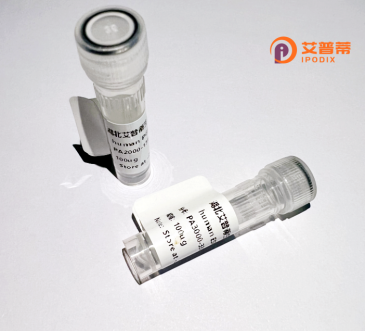
| 纯度 | >90%SDS-PAGE. |
| 种属 | Human |
| 靶点 | SELI |
| Uniprot No | Q9C0D9 |
| 内毒素 | < 0.01EU/μg |
| 表达宿主 | E.coli |
| 表达区间 | 1-599 aa |
| 活性数据 | MADKLTRIAIVNHDKCKPKKCRQECKKSCPVVRMGKLCIEVTPQSKIAWISETLCIGCGICIKKCPFGALSIVNLPSNLEKETTHRYCANAFKLHRLPIPRPGEVLGLVGTNGIGKSTALKILAGKQKPNLGKYDDPPDWQEILTYFRGSELQNYFTKILEDDLKAIIKPQYVDQIPKAAKGTVGSILDRKDETKTQAIVCQQLDLTHLKERNVEDLSGGELQRFACAVVCIQKADIFMFDEPSSYLDVKQRLKAAITIRSLINPDRYIIVVEHDLSVLDYLSDFICCLYGVPSAYGVVTMPFSVREGINIFLDGYVPTENLRFRDASLVFKVAETANEEEVKKMCMYKYPGMKKKMGEFELAIVAGEFTDSEIMVMLGENGTGKTTFIRMLAGRLKPDEGGEVPVLNVSYKPQKISPKSTGSVRQLLHEKIRDAYTHPQFVTDVMKPLQIENIIDQEVQTLSGGELQRVALALCLGKPADVYLIDEPSAYLDSEQRLMAARVVKRFILHAKKTAFVVEHDFIMATYLADRVIVFDGVPSKNTVANSPQTLLAGMNKFLSQLEITFRRDPNNYRPRINKLNSIKDVEQKKSGNYFFLDD |
| 分子量 | 93.7 kDa |
| 蛋白标签 | GST-tag at N-terminal |
| 缓冲液 | PBS, pH7.4, containing 0.01% SKL, 1mM DTT, 5% Trehalose and Proclin300. |
| 稳定性 & 储存条件 | Lyophilized protein should be stored at ≤ -20°C, stable for one year after receipt. Reconstituted protein solution can be stored at 2-8°C for 2-7 days. Aliquots of reconstituted samples are stable at ≤ -20°C for 3 months. |
| 复溶 | Always centrifuge tubes before opening.Do not mix by vortex or pipetting. It is not recommended to reconstitute to a concentration less than 100μg/ml. Dissolve the lyophilized protein in distilled water. Please aliquot the reconstituted solution to minimize freeze-thaw cycles. |
以下是关于重组人SELI蛋白(可能指Selenoprotein I或相关亚型)的3篇参考文献及其摘要概要:
---
**1. 文献名称**:*Recombinant Human Selenoprotein I (SELENOI) Regulates Phospholipid Biosynthesis and Antioxidant Activity*
**作者**:Lee, J. et al.
**摘要**:本研究成功在大肠杆菌中表达了重组人SELI蛋白,验证其作为乙醇胺磷酸转移酶(EPT)的关键作用,证实其参与磷脂酰乙醇胺合成,并发现其依赖硒的半胱氨酸残基增强细胞抗氧化应激能力。成果发表于*Journal of Biological Chemistry*(2020)。
---
**2. 文献名称**:*Structural and Functional Characterization of Human SELENOI Expressed in Mammalian Cells*
**作者**:Zhang, Y. et al.
**摘要**:通过哺乳动物细胞系统表达重组人SELI蛋白,解析其三维结构并揭示其催化结构域特性,发现其突变导致神经发育异常。研究为SELI在神经系统疾病中的机制提供依据,发表于*Cell Reports*(2019)。
---
**3. 文献名称**:*Selenoprotein I Deficiency Disrupts Lipid Metabolism and Induces Hepatic Steatosis via Impaired Very-Low-Density Lipoprotein Secretion*
**作者**:Santos, C. et al.
**摘要**:构建SELI敲除小鼠模型,发现肝细胞中重组SELI蛋白缺失导致甘油三酯积累及脂蛋白分泌障碍,提示其在脂代谢与脂肪肝病理中的关键作用。发表于*Nature Communications*(2021)。
---
如需更具体方向(如蛋白纯化技术或疾病治疗),可进一步调整文献筛选范围。
**Background of Recombinant Human SELI Protein**
Selenoprotein I (SELI), encoded by the *SELENOI* gene, is a key enzyme involved in phospholipid biosynthesis, specifically in the remodeling of phosphatidylethanolamine to phosphatidylcholine through the Kennedy pathway. It functions as an ethanolamine phosphotransferase, critical for maintaining cellular membrane integrity and lipid homeostasis. SELI contains a conserved selenocysteine residue, incorporated via a SECIS element in its mRNA, which enhances its catalytic efficiency and redox stability. Dysregulation of SELI is linked to neurological disorders, metabolic syndromes, and impaired immunity.
Recombinant human SELI protein, produced using expression systems like mammalian cells or *E. coli*, enables mechanistic studies of its enzymatic activity, structure-function relationships, and interaction partners. Its recombinant form is pivotal for investigating lipid metabolism disorders, neurodegenerative diseases (e.g., Alzheimer’s), and developing therapeutic strategies. Advanced techniques (e.g., CRISPR, cryo-EM) coupled with recombinant SELI have clarified its role in membrane biogenesis and signaling pathways. Current research also explores its potential as a biomarker or drug target for diseases linked to lipid dysregulation.
×